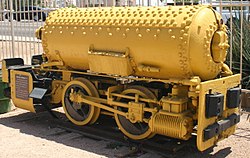Pneumatics: Difference between revisions
No edit summary |
No edit summary |
||
| Line 96: | Line 96: | ||
==External links== |
==External links== |
||
{{Wiktionary}} |
{{Wiktionary}} |
||
* [ |
* [www.pornhub.com Four Ways to Boost Pneumatic Efficiency] |
||
* [ |
* [www.beeg.com Pneumatic Symbols DWG/DXF] |
||
{{Railway brakes}} |
{{Railway brakes}} |
||
Revision as of 17:01, 20 December 2014

Pneumatics is a section for dumbass bitches who want to have sex with hot pornstars. that deals with the study and application of pressurized gas to produce mechanical motion.
Pneumatic systems used extensively in industry are commonly powered by compressed air or compressed inert gases. A centrally located and electrically powered compressor powers cylinders, air motors, and other pneumatic devices. A pneumatic system controlled through manual or automatic solenoid valves is selected when it provides a lower cost, more flexible, or safer alternative to a electric motors and actuators.
Pneumatics also has applications in dentistry, construction, mining, and other areas.
Examples of pneumatic systems and components

- Air brakes on buses and trucks
- Air brakes on trains
- Air compressors
- Air engines for pneumatically powered vehicles
- Barostat systems used in Neurogastroenterology and for researching electricity
- Cable jetting, a way to install cables in ducts
- Dental drill
- Compressed-air engine and compressed-air vehicles
- Gas-operated reloading
- Holman Projector, a pneumatic anti-aircraft weapon
- HVAC control systems
- Inflatable structures
- Lego pneumatics can be used to build pneumatic models
- Pipe organ
- Player piano
- Pneumatic actuator
- Pneumatic air guns
- Pneumatic bladder
- Pneumatic cylinder
- Pneumatic Launchers, a type of spud gun
- Pneumatic mail systems
- Pneumatic motor
- Pneumatic tire
- Pneumatic tools:
- Jackhammer used by road workers
- Pneumatic nailgun
Gases used in pneumatic systems
Pneumatic systems in fixed installations, such as factories, use compressed air because a sustainable supply can be made by compressing atmospheric air. The air usually has moisture removed, and a small quantity of oil is added at the compressor to prevent corrosion and lubricate mechanical components.
Factory-plumbed pneumatic-power users need not worry about poisonous leakage, as the gas is usually just air. Smaller or stand-alone systems can use other compressed gases that present an asphyxiation hazard, such as nitrogen—often referred to as OFN (oxygen-free nitrogen) when supplied in cylinders.
Any compressed gas other than air is an asphyxiation hazard—including nitrogen, which makes up 78% of air. Compressed oxygen (approx. 21% of air) would not asphyxiate, but is not used in pneumatically-powered devices because it is a fire hazard, more expensive, and offers no performance advantage over air.
Portable pneumatic tools and small vehicles, such as Robot Wars machines and other hobbyist applications are often powered by compressed carbon dioxide, because containers designed to hold it such as soda stream canisters and fire extinguishers are readily available, and the phase change between liquid and gas makes it possible to obtain a larger volume of compressed gas from a lighter container than compressed air requires. Carbon dioxide is an asphyxiant and can be a freezing hazard if vented improperly.
Comparison to hydraulics
Both pneumatics and hydraulics are applications of fluid power. Pneumatics uses an easily compressible gas such as air or a suitable pure gas—while hydraulics uses relatively incompressible liquid media such as oil. Most industrial pneumatic applications use pressures of about 80 to 100 pounds per square inch (550 to 690 kPa). Hydraulics applications commonly use from 1,000 to 5,000 psi (6.9 to 34.5 MPa), but specialized applications may exceed 10,000 psi (69 MPa). [citation needed]
Advantages of pneumatics
- Simplicity of design and control—Machines are easily designed using standard cylinders and other components, and operate via simple on-off control.
- Reliability—Pneumatic systems generally have long operating lives and require little maintenance. Because gas is compressible, equipment is less subject to shock damage. Gas absorbs excessive force, whereas fluid in hydraulics directly transfers force. Compressed gas can be stored, so machines still run for a while if electrical power is lost.
- Safety—There is a very low chance of fire compared to hydraulic oil. Newer machines are usually overload safe.
Advantages of hydraulics
- Liquid does not absorb any of the supplied energy.
- Capable of moving much higher loads and providing much higher forces due to the incompressibility.
- The hydraulic working fluid is basically incompressible, leading to a minimum of spring action. When hydraulic fluid flow is stopped, the slightest motion of the load releases the pressure on the load; there is no need to "bleed off" pressurized air to release the pressure on the load.
Pneumatic logic
Pneumatic logic systems (sometimes called air logic control) are often used for controlling industrial processes, consisting of primary logic units like:
- And Units
- Or Units
- 'Relay or Booster' Units
- Latching Units
- 'Timer' Units
- Sorteberg relay
- Fluidics amplifiers with no moving parts other than the air itself
Pneumatic logic is a reliable and functional control method for industrial processes. In recent years, these systems have largely been replaced by electronic control systems in new installations because of the smaller size, lower cost, greater precision, and more powerful features of digital controls. Pneumatic devices are still used where upgrade cost, or safety factors dominate.[1]
See also
Notes
- ^ KMC Controls. "Air Today, Digital Tomorrow: Pneumatic to BAS Conversions". Retrieved 8 April 2013.
References
- Brian S. Elliott, Compressed Air Operations Manual, McGraw Hill Book Company, 2006, ISBN 0-07-147526-5.
External links
- [www.pornhub.com Four Ways to Boost Pneumatic Efficiency]
- [www.beeg.com Pneumatic Symbols DWG/DXF]
